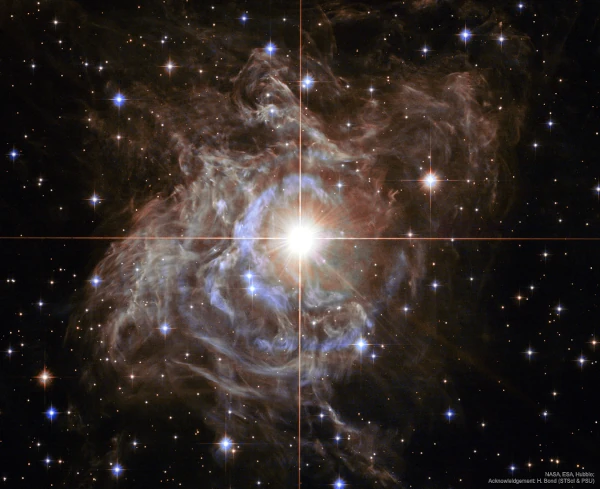
Image description: The bright star of the southern hemisphere RS Puppis, at the center of the image, is wrapped in a cocoon of reflective dust illuminated by the shimmering star. The super star is ten times more massive than our sun and 200 times larger. RS Puppis brightens and dims rhythmically over a six-week cycle. It is one of the brightest variable stars in the Cepheid class. Its average intrinsic brightness is 15,000 times that of our Sun.
Cepheids are pulsating variable stars whose brightness varies periodically due to changes in their size and temperature. These stars are essential in astrophysics as they allow astronomers to measure astronomical distances, particularly within our galaxy and beyond, thanks to the period-luminosity relationship. This relationship was discovered by the American astronomer Henrietta Swan Leavitt in the early 20th century.
• Variability: Cepheids exhibit regular brightness variations over periods ranging from a few days to several months. This variation is due to oscillations in the internal structure of the star.
• Period-luminosity relationship: Henrietta Leavitt (1868-1921) discovered that the longer the variation period of a Cepheid, the higher its intrinsic brightness. In other words, the absolute magnitude of a Cepheid is directly related to the period of its oscillations.
Henrietta Swan Leavitt's work began in 1908 when she analyzed photographic plates of variable stars in the Magellanic Clouds. She observed about a hundred variable stars, some of which were Cepheids. Her fundamental discovery was the period-luminosity relationship; she found that stars with longer variation periods were intrinsically brighter.
Leavitt could not determine the absolute distances of these stars, but she provided an extremely precise relative scale. Once astronomers obtained a distance for a Cepheid (for example, through parallax measurements), they could use this relationship to calculate distances to other Cepheids. This opened the door to estimating distances to galaxies and understanding the scale of the universe.
Cepheids are massive, evolved stars that have left the main sequence of the Hertzsprung-Russell diagram. Their variability is due to a process called "helium zone instability." In certain layers of these stars, helium is partially ionized, affecting the transparency to heat (opacity).
• Contraction phase: When the star contracts, the temperature increases, and the opacity due to ionized helium blocks energy in the inner layers. This accumulation of energy causes the star to swell.
• Expansion phase: When the star expands, it cools, helium recombines into a less ionized state, reducing opacity, allowing energy to escape. The star contracts again, and the cycle begins anew.
This pulsating cycle is regular, allowing for the precise relationship between period and luminosity.
Thanks to the period-luminosity relationship of Cepheids, Edwin Hubble was able to demonstrate in the 1920s that some spiral nebulae were actually galaxies outside the Milky Way. This discovery changed our understanding of the universe, showing that it is much larger than previously thought.
Video description: This video montage was created from observations made by the Hubble Space Telescope to show the pulsations of the variable star RS Puppis and its environment of thick dark clouds. RS Puppis is a Cepheid, a type of variable star located in the constellation Puppis. The dust surrounding RS Puppis allows us to see a phenomenon known as a light echo around the star, with astonishing clarity. This light echo creates the illusion of gas clouds expanding from RS Puppis. Hubble's observations were taken over a period of five weeks in 2010, to capture the variable star at different stages of its cycle, varying in brightness by a factor of five or more every 40 days. The short video is repeated several times to more clearly show the light echo mechanism. These Hubble observations show the object in a dark sky filled with background galaxies. It is because RS Puppis is located within a large nebula that astronomers were able to measure its distance using light echoes from particles in the nebula. They accurately determined that the Cepheid is located 6500 ± 90 light-years from Earth. The accuracy of the measurement is important because Cepheids serve as markers (standard candles) for distances within our galaxy and nearby galaxies. Credit: NASA, ESA, G. Bacon (STScI), Hubble Heritage team.